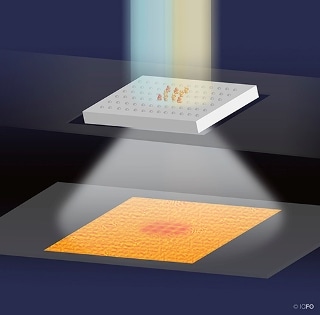Jun 16 2016
Researchers from ICFO have invented a cost-effective, portable, and compact on-chip light microscope that has the potential to perform ultra sensitive analysis of transparent objects.
 Large field of view interferometric microscope can detect single protein layers (Credit: ICFO)
Large field of view interferometric microscope can detect single protein layers (Credit: ICFO)
Phase contrast, holographic, or differential interference contrast (DIC) microscopes are often used to create “visible”, otherwise “invisible”, objects that are transparent. This invention has made room for studying and understanding the characterization of appropriate structures like protein layers or biological cells. Carl Zeiss developed the DIC microscope several decades ago, and this microscope has extreme popularity in this field.
These techniques have proven to be limited in regard to depth-of-field (DOF) and field-of-view (FOV), despite the fact that they have provided high resolution and sensitivity. This limitation is indeed a drawback when speaking of bigger samples, where a scanning method is time consuming and mandatory. A trade-off will always be there when attempting to enhance one parameter with a particular combination of lenses, the other eventually deteriorates. Recent research focuses on creating microscopes devoid of objectives or optical lenses, which could provide unparalleled FOV while maintaining reasonable resolution and sensitivity.
Science Advances has published a paper in which ICFO researchers Roland Terborg, Josselin Pello, Ilaria Mannelli, UPC Prof. at ICFO Juan P. Torres and ICREA Prof. at ICFO Valerio Pruneri, have together developed a unique on-chip microscope, which is compact and cost-effective. This new microscope has been built with consumer electronic products that can simultaneously measure nanometer-thick changes over a large volume (0.5 cm^3) in glass and other transparent objects.
A large FOV interferometric on-chip lens free microscope (LIM) has been created by the researchers based on a unique design with an extremely axial sensitivity and DOF. The team used an appropriate technique that is utilized in microarray platforms to identify proteins without any labels.
The challenge of developing a lens-free microscope to detect single protein layers (less than 1nm of optical path difference) seemed rather difficult at the beginning. But as we started to develop the device, everything seemed to fit in very well surpassing our expectations! Instead of having to use very expensive components, we discovered that we could actually use consumer end products without a significant decrease in its sensitivity.
Roland Terborg, Researcher, ICFO
The researchers used collimated polarized light to reconstruct the image. This light was used to shine through the transparent sample in order to study and examine the phase shift and interference intensity pattern, a method referred to as phase-shifting interferometry (PSI).
As UPC Prof at ICFO Juan P. Torres states, “any slight refractive index change introduced by an impurity in the sample is translated into a phase difference and thus an intensity variation in the pattern, showing the contours and therefore size of the irregularity”.
The device means a major step forward for light microscopy techniques, especially for microarray platforms since it could definitely be used as a point-of-care tool in the diagnosis and treatment of major diseases such as Sepsis, a critical area where fast and accurate results can translate into life changing health outcomes for individuals. We are also thrilled by the fact that this will be part of the Sixsenso spin-off project portfolio including similar devices for detection of particulates and micro-organisms.
Valerio Pruneri, ICREA Prof., ICFO
The new device developed by the team has been shown to be compact, cost-effective, and highly appropriate for point-of-care applications, making it a perfect device to integrate into cameras of tablets or smart phones. This device can also be used to identify and scan transparent surfaces or objects.